The Washington Project

Sunrise at the San Juan Islands, Summer 2010
The "Washington Project" is a series of woodblock
prints, on which I started working in 2010. I want to tell here how this
happened.
For some years now the Cullom Gallery in Seattle, Washington
State, USA, is representing my work. In the Summer of 2010 I went there to attend
an opening of a show. It was my first visit and before I went, many people
had told me about the area's beauty, especially of the San Juan Islands. I should
go there in any case. I would have liked that, but doubted that it might be
possible with me not having a driver's license. Beth Cullom, the gallery owner,
had the idea too... and then a friend of the gallery, Joe Kaftan, took some
time, and we went to the islands, he for writing, and me for designing prints.
Joe knew the islands very well. He decided that I would work on the top of the
highest mountain at sunrise.
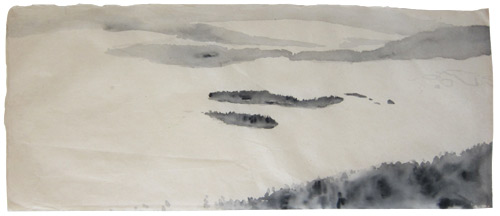
I did some ink paintings and designed several prints which I
executed at home.
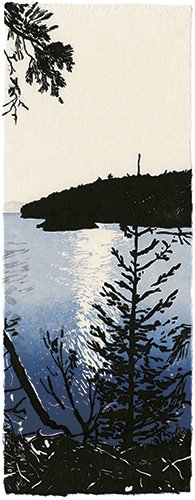
Why does an artist, who is living in Berlin, travel to North
America to work there? Since 2007 this opportunity has offered itself to me
by several invitations. I had joined colleagues going to Canadian National Parks
or wide and lonely landscapes in the US. As I wish to touch deep and untouched
areas in my art, working there was very satisfying for me.
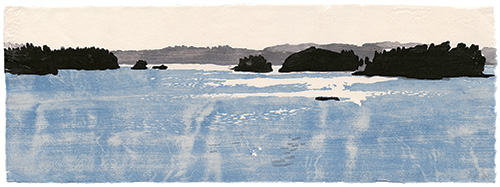
"Art doesn't come out of a crack in the wall", that
is something Beth says, which she wants to communicate to her customers. When
I was planning another work stay in the US in the Spring of 2011, both of us
had the idea to continue with the series, from the San Juan Islands to more
places from Washington State. Beth and Joe would come with me, watch me doing
my sketches and document it in a way, as an example of how art is done. Beth
called this the "Washington Project".
Day one, April 16th, 2011
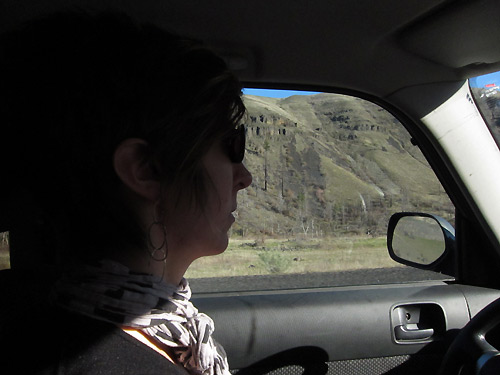
Beth and I drove from Seattle to Eastern Washington. In the
afternoon we arrived at our headquarter, the village Tieton, and at once started
to search for a place to make a woodblock print design. We drove along a river,
with exiting hillsides from basalt rock. I realized it was not easy to explain
for what I was looking, why a spot would be the "right one". I need
the "right" light, often coming from the front which, due to the contrasts,
makes it easier to reduce the image to a few shades = plates. It has to allow
a composition with tension and meaning, with elements which are referring to
each other. Also, everything should not be too far away, and...
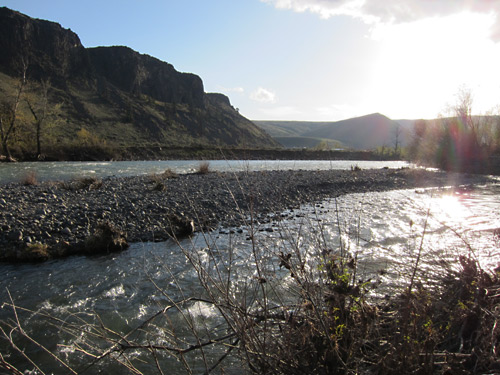
I found it a bit embarrassing to say again and again: "No,
it is not the right spot". Here it was the pointless median, and the chaotic
plant in the foreground.
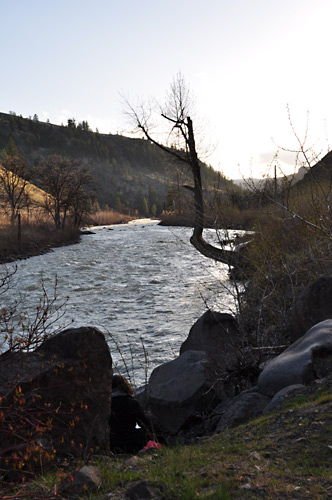
But then there was the right spot, and I started my
sketch. The sun went down quickly and I had to hurry.
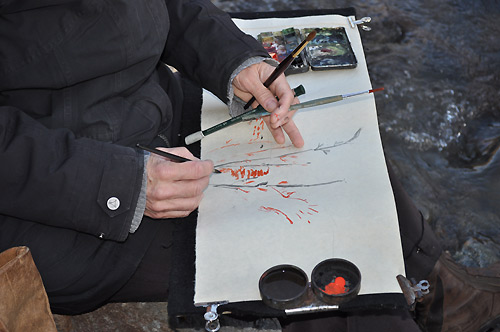
When I am doing a sketch for a print, it is enough to draw lines
and outer lines of bigger areas. I don't have to color everything, I can concentrate
on the relevant parts. I think that this is benefiting for the final print.
Day 2
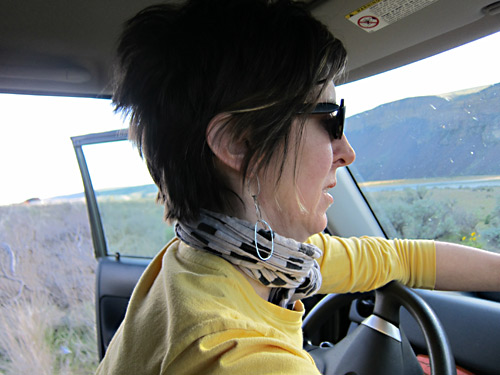
Washington State is highly interesting in geological terms and
full of monumental landscapes, which are revealing their formation millions
of years ago. Beth had researched some potential places and we started for the
striking Steamboat Rock. During the long drive we passed many compositionally
interesting spots. We finally stopped on a plain with a high rock wall rising
up behind a sparkling lake, and white birds circling around in the distance.
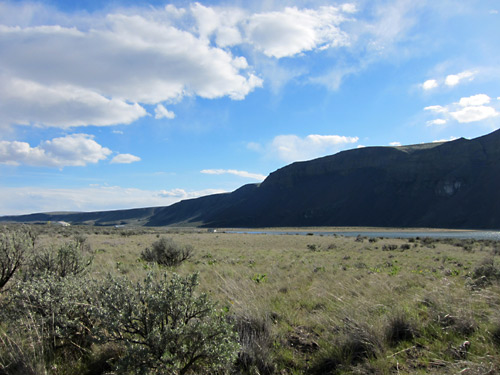
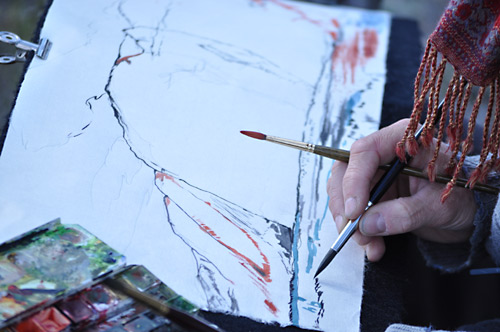
We drove on and passed a lake with three rocks.
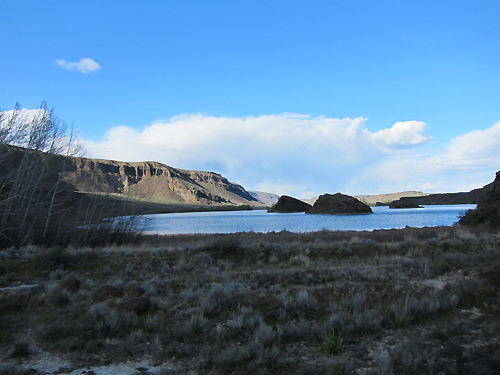
I made a sketch. The sun was standing deep and we still had
a long drive to go.
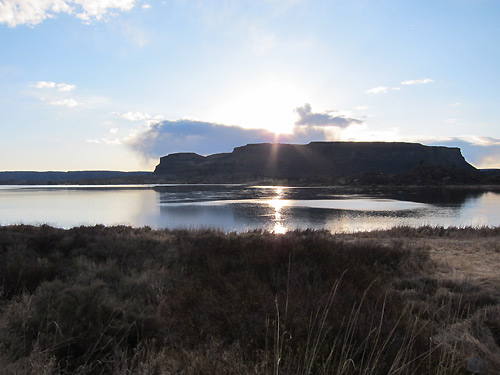
When we arrived, the sun was just going to set behind the rock.
I realized that I had only a couple minutes and just started. The time pressure
was beneficial.
Day 3
On the next day we drove into another direction, along a wild
river going through a forest. We stopped at a camping ground and checked the
area. Beth had spent holidays in places like this as a child and had loved the
huge pine trees. If I could make a print of such a pine tree? Yes. We searched
and found the perfect representative, "The Pine Tree". Then we drove
on and came to a mystical marshy place.

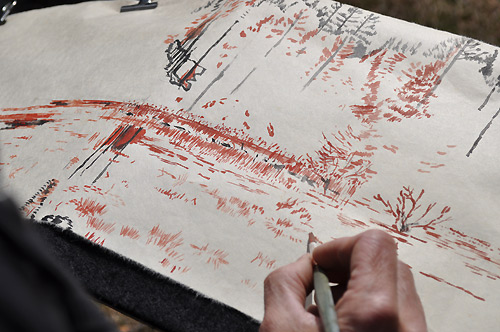
Later we went back to the camping ground and looked for "The
Pine Tree". We ran around and looked and couldn't find it. Everything looked
different. Finally we decided for a tree, which could be it.
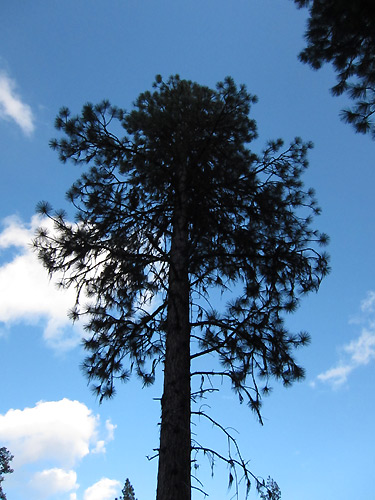
I lied under the tree and started drawing. Endlessly many branches
and pins had to be drawn. I felt that I didn't have the power and conviction.
I realized that I was failing and stopped.
Day 4
Back in Seattle. Joe, who had offered to go with me, was sick.
Another friend of the gallery, Mark Minerich, offered to go with me to Mount
Rainier, south of Seattle. Mt. Rainier is Washington's highest mountain and
a meaningful symbol.
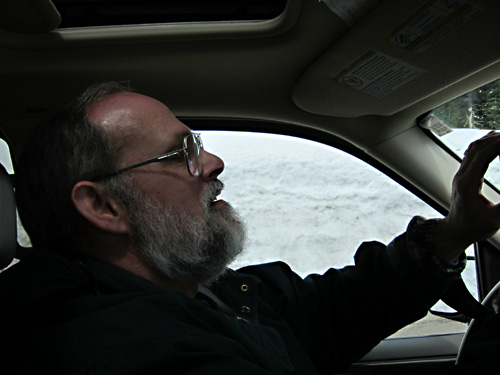
Mark has studied art in his youth and then decided for a career
which allowed him to continue with his art work. Now in retirement, he was able
to spend more time on this and did that too by supporting Beth in the gallery.
Beth had shown me an image of a woodblock print, designed by
the Japanese artist Hiroshi Yoshida in the twenties at Mt. Rainier with a well
visible mountain peak. This was looking very good. Beth meant that this view
was from the point "Paradise". So this was our destination. When we
arrived, everything looked very different. The peak was somewhere above us in
the clouds. We drove and walked around, me without being able to communicate
to Mark what I was looking for, again a bit embarrassing. But there was a good
spot.
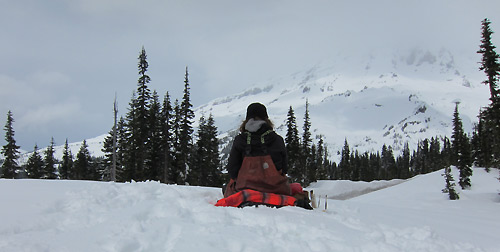
We met animals.

Day 5
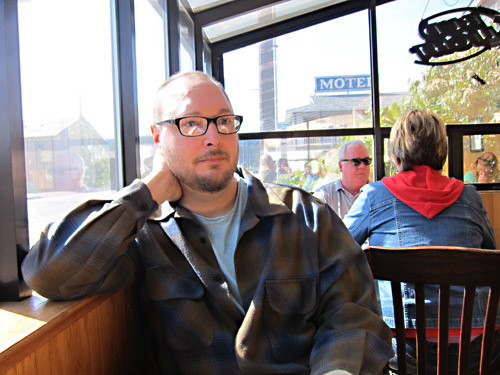
This is Joe Kaftan. He is designer-artist and also kayak guide.
From his tours he knows Washington's coast and islands very well.
Joe and I drove to the Olympic Peninsula west of Seattle. The
Olympic Peninsula is very beautiful, with lonely untouched beaches, a rain forest
and mountains. There are some Native American reservations, but the island is
quite uninhabited.
Joe showed me a beach with a small island overgrown by trees.
Very beautiful and exciting. I was actually still tired from the print sketches
during the last days and didn't feel like working. But Joe meant that I should
make a design there. So I did.
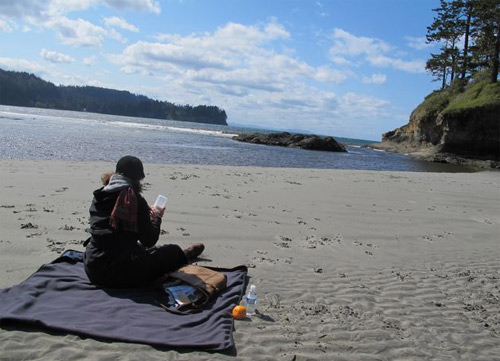
Very surprisingly the flood came and I again had to hurry.
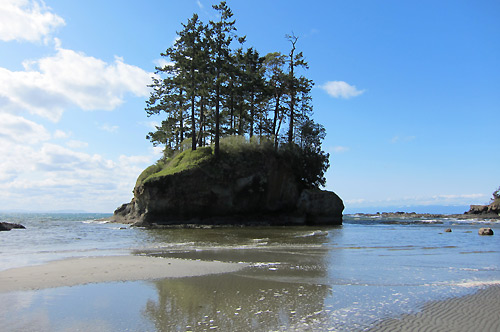
We drove on and passed a beautiful lake, sparkling behind trees.
No parking. When we found a parking area, there were no trees. So we drove back, I left the car and Joe collected me later.
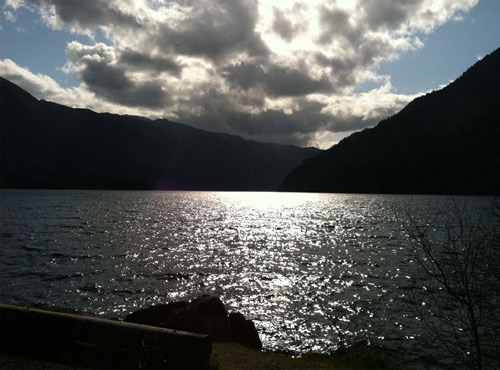
Day 6
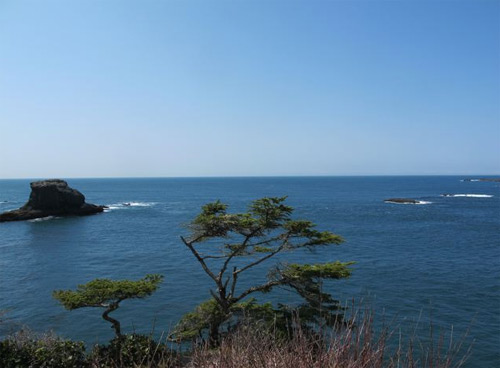
We went to Cape Flattery, the North-West end of the USA. After
having crossed a forest we arrived at the Cape. It was nice but there was not much "material" for a woodblock print.
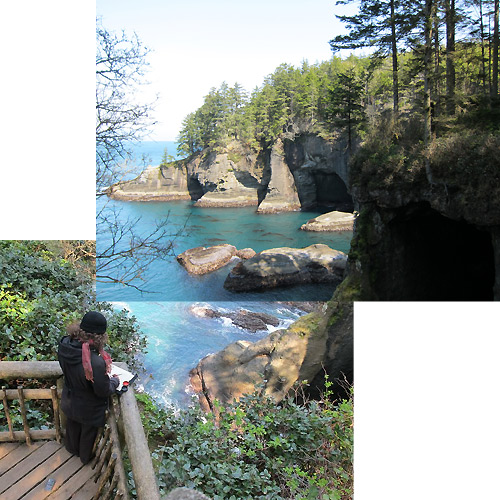
On the cape's North side was a spot with a wild view on dark
caves and rocks in the sea.
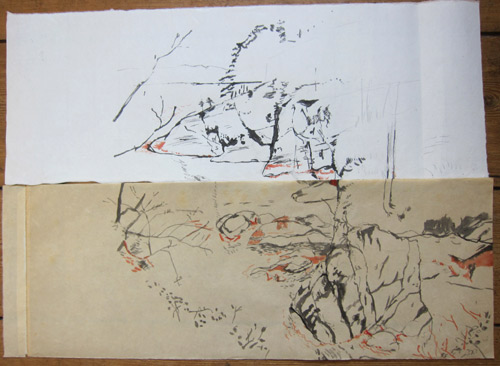
I started to draw, and then had to add another sheet. There
were so many caves and rocks, and SO many trees. I realized that I was rather
documenting then composing and stopped.
I found the perfect spot on the Southern side, with motions
and countermotions and nice back light.
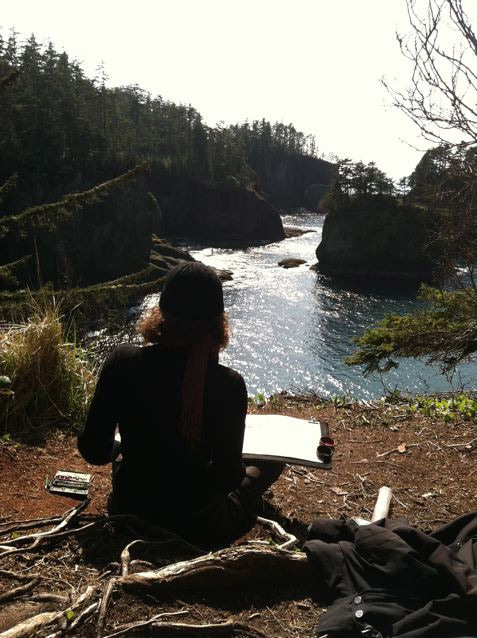
We moved on to another promising beach, Shi Shi Beach. After
a long hike through a muddy jungle, we arrived. There was an exciting jagged
coast line, but far away.

The other side didn't have the right light.
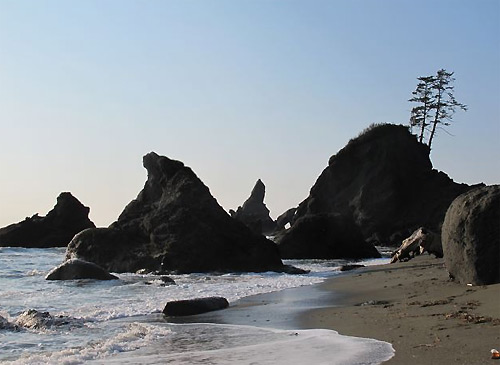
I tried to make something with the big log.
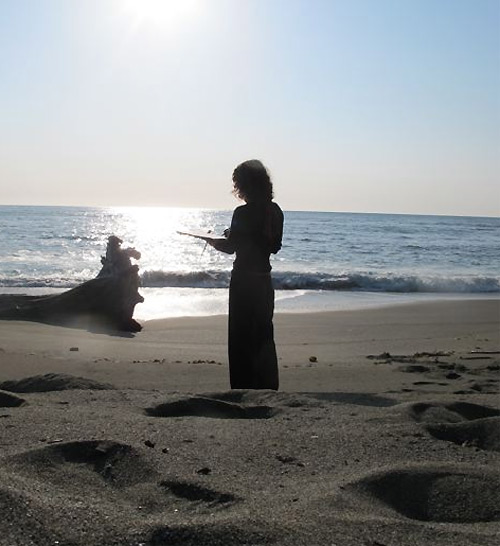
Day 7
The last day, there were two places to go. First the beach from
La Push, it should be very beautiful. We again crossed a forest.
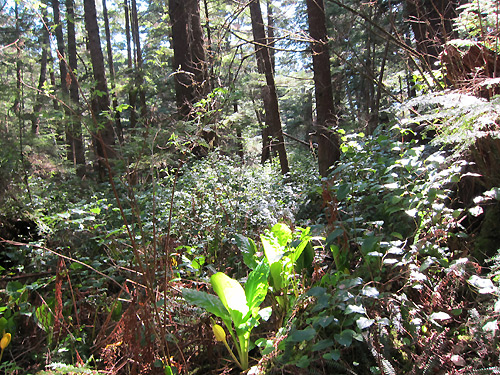
We were welcomed by an unbelievable scenery.
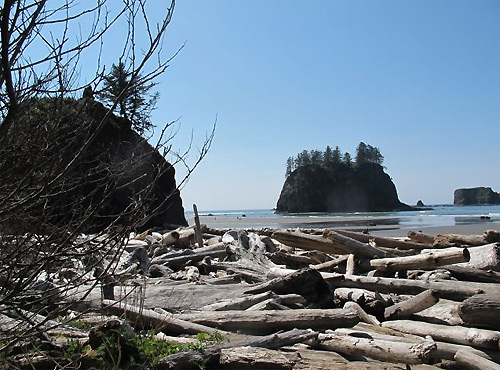
I started working.
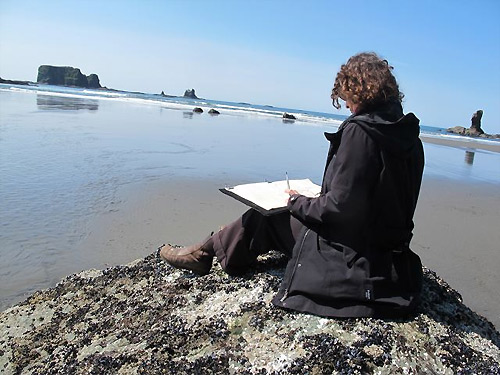
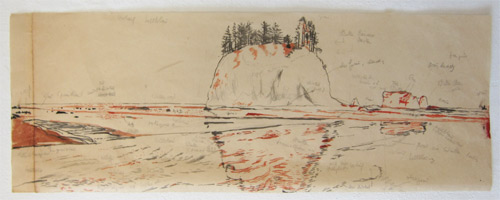
Beth had asked us to go to the Hoh National Forest, a rain forest.
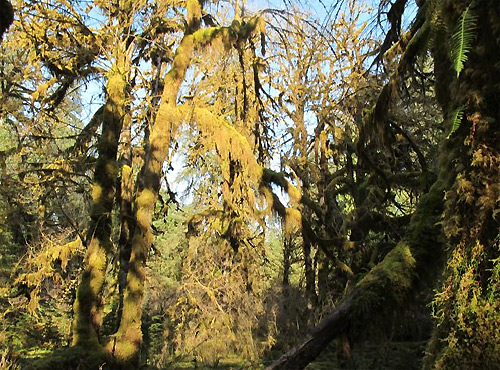
Going there, I saw from the car through the trees a wide riverbed.
A thin river was running through it. Huge white dead trees were lying everywhere.
Dead trees were rising aslant. In the distance high mountains.
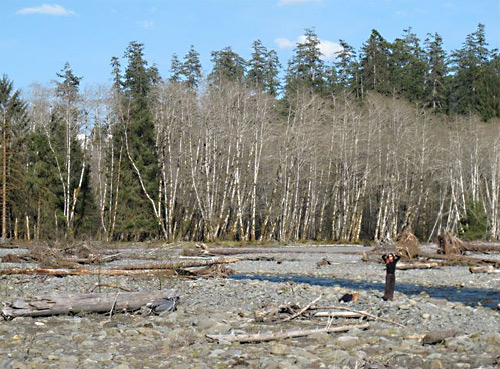
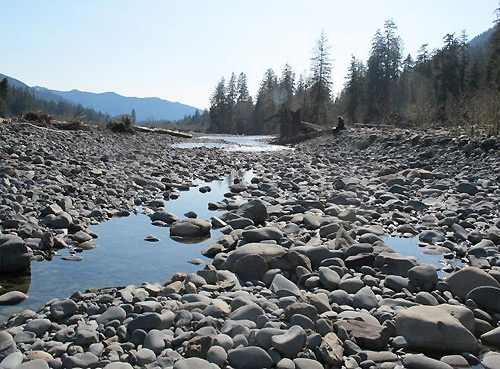
After my sketch I felt that the work was completed.
On our way back we saw many beautiful places.
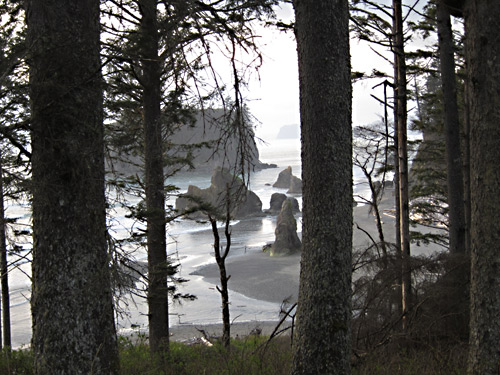
May 2011 - February 2012
When I came home, I started working on the prints.
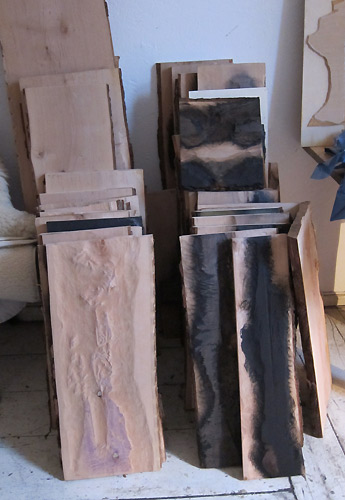
I bought new wood and started cutting.

Besides other things, which also had to be done, I cut ten months.
While I was cutting the landscapes, I walked again through them, and I remembered
the talks with my friends.
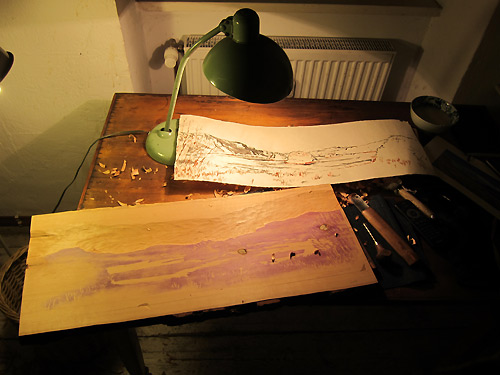
A first rubbing:
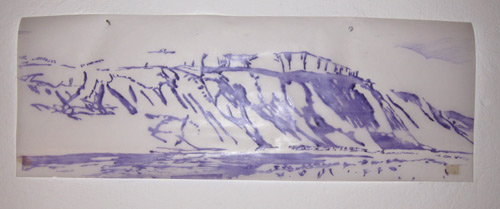
Then I started proofing.
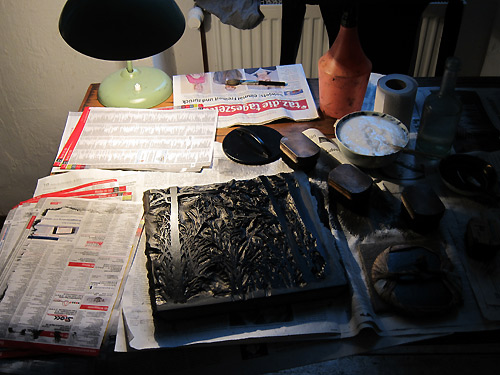
The Prints
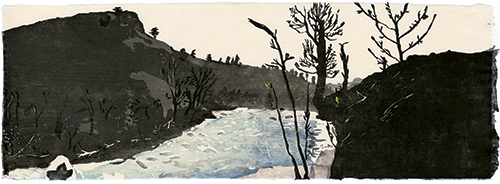

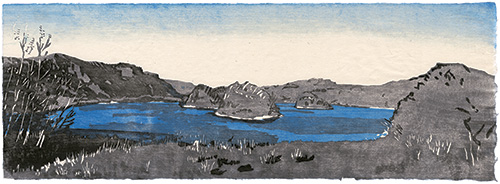



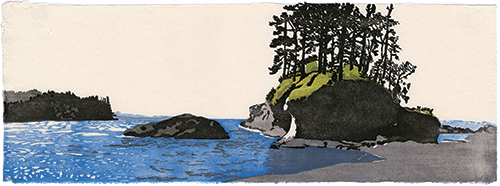
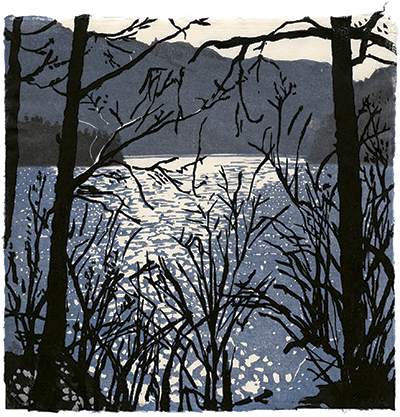
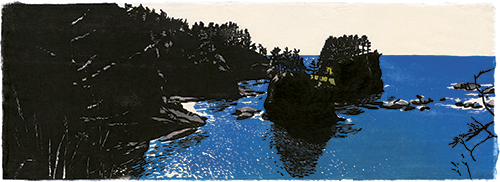

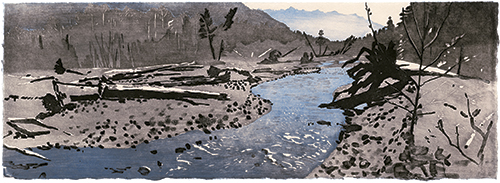
These prints were created due to the commitment of Beth, Mark
and Joe.
Thank you so much.
February 2012
(Fotos by Beth Cullom, Mark Minerich, Joe Kaftan and me)
PS Travelling from Berlin to Wyoming and Washington in April
2011 caused 6840 kg CO2. I offset these flights at  www.atmosfair.de.
www.atmosfair.de.
 |